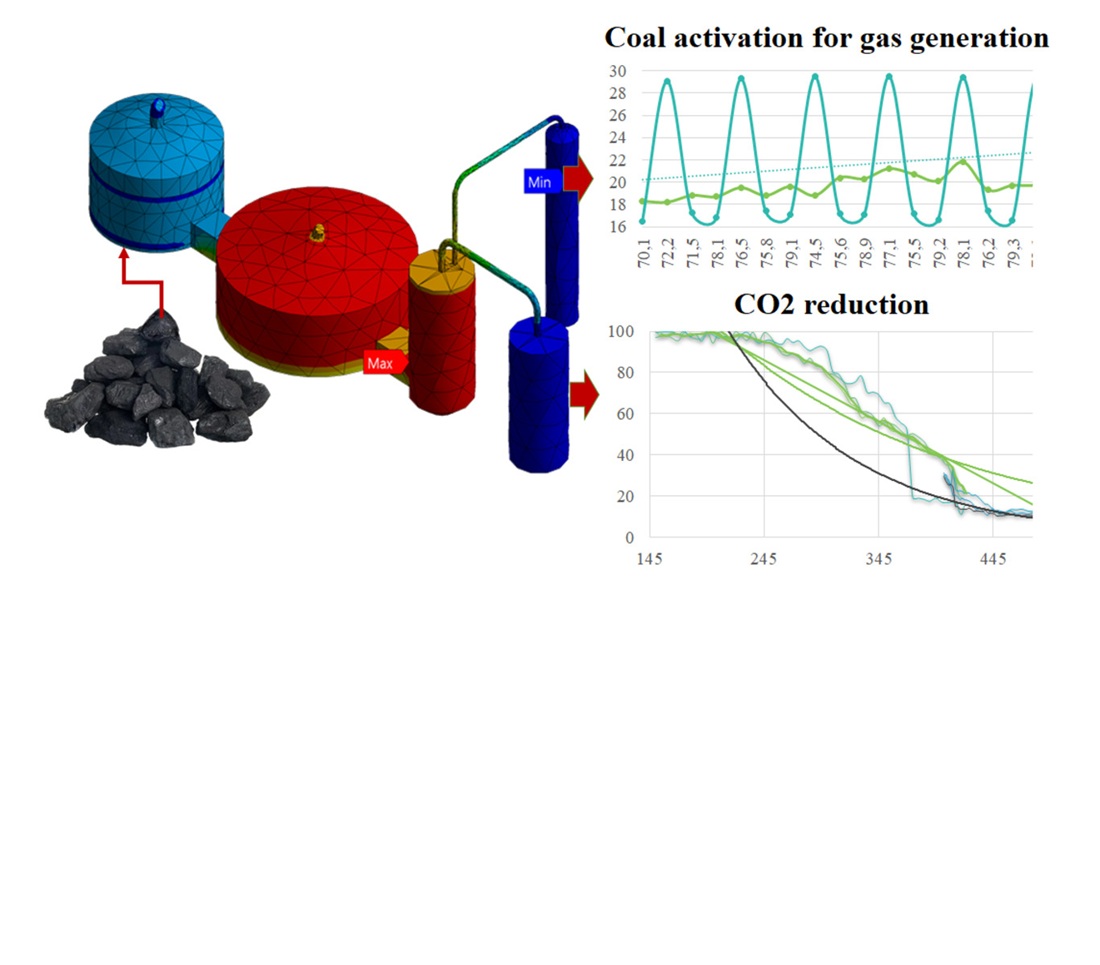Оцінка впливу раптового теплового впливу на виділення летких газів під час процесу газифікації слабометаморфізованого вугілля
DOI:
https://doi.org/10.15587/1729-4061.2025.331223Ключові слова:
слабометаморфізоване вугілля, раптове нагрівання, енергія деформації, термогравіметричний аналіз, термічна напругаАнотація
Об'єктом дослідження є низькотемпературна технологія газифікації слабометаморфізованого вугілля. Одним з невирішених питань низькотемпературної технології газифікації слабометаморфізованого вугілля залишається тривалий період обробки через те, що слабка енергія активації вугілля безпосередньо залежить від виділення летких газів, які залежать від ізотропного стану вугілля. Вирішена проблема полягає у збільшенні енергії активації вугілля за рахунок раптового нагрівання під час термічної обробки. Отримані результати показують зміщення початку виділення летких газів з температури 410°C на таку ж величину, як і при поступовому нагріванні до температури 500°C. Крім того, раптове нагрівання сприяє зменшенню викидів CO2 на 12%, що свідчить про покращення екологічних показників. Ці результати пояснюються тим, що різка різниця температур 20°C та 400°C створює умови для появи енергетичних спотворень в ізотропних зонах нагрівання вугільного тіла. Ця енергія послаблює та руйнує внутрішні зв'язки між частинками вугілля та створює умови для виділення нових летких елементів при нижчих температурах. Основними особливостями отриманих результатів, які дозволили вирішити досліджувану задачу, є результати щодо перетворення термічних напружень в енергію деформації при раптовому нагріванні у взаємозв'язку між механікою та фізикою анізотропного вугілля. Обсяг та умови практичного використання отриманих результатів дозволять коригувати методи газифікації вугілля з низьким ступенем метаморфізму та встановлювати режими газифікації з урахуванням конструкції та потужності газогенераторів
Посилання
- Wang, Y., Schaffers, W. C., Tan, S., Kim, J. S., Boardman, R. D., Bell, D. A. (2020). Low temperature heating and oxidation to prevent spontaneous combustion using Powder River Basin coal. Fuel Processing Technology, 199, 106221. https://doi.org/10.1016/j.fuproc.2019.106221
- Wang, Y., Sun, Y., Dai, L., Wang, K., Cheng, G. (2023). Mechanisms of CO and CO2 Production during the Low-Temperature Oxidation of Coal: Molecular Simulations and Experimental Research. Fire, 6 (12), 475. https://doi.org/10.3390/fire6120475
- Song, H., Liu, G., Zhang, J., Wu, J. (2017). Pyrolysis characteristics and kinetics of low rank coals by TG-FTIR method. Fuel Processing Technology, 156, 454–460. https://doi.org/10.1016/j.fuproc.2016.10.008
- Zhu, Y., Li, K., Wang, Q., Cen, J., Fang, M., Luo, Z. (2022). Low-rank coal pyrolysis polygeneration technology with semi-coke heat carrier based on the dual-fluidized bed to co-produce electricity, oil and chemical products: Process simulation and techno-economic evaluation. Fuel Processing Technology, 230, 107217. https://doi.org/10.1016/j.fuproc.2022.107217
- Zang, C., Zhou, J., Chen, M., Bai, F., Zhao, Z. (2023). Study on the Instability Mechanism of Coal and Rock Mining under a Residual Coal Pillar in Gently Inclined Short-Distance Coal Seam with the Discrete Element. Sustainability, 15 (7), 6294. https://doi.org/10.3390/su15076294
- Zhou, H., Yao, J., Chen, S., Li, H., Chen, Y., Wu, X. (2024). Effect of moisture content on charging and triboelectrostatic separation of coal gasification fine ash. Separation and Purification Technology, 333, 125976. https://doi.org/10.1016/j.seppur.2023.125976
- Liu, H., Li, M., Zhao, S., Jiang, L., Xu, Q., Majlingová, A. (2024). Applications of distributed activation energy model on the pyrolysis of green renewable wood. Fuel, 359, 130457. https://doi.org/10.1016/j.fuel.2023.130457
- Zhang, T., Zhang, C., Ren, H., Huang, Z., Feng, J., Liu, N. et al. (2025). Co-pyrolysis of coal-derived sludge and low-rank coal: Thermal behaviour and char yield prediction. Fuel Processing Technology, 267, 108165. https://doi.org/10.1016/j.fuproc.2024.108165
- Xu, D., Yang, L., Liu, H., Sun, S., Ma, M., Zhi, Y. (2024). Co-pyrolysis characteristics and kinetics of rice straw and low rank coal. Journal of Analytical and Applied Pyrolysis, 183, 106741. https://doi.org/10.1016/j.jaap.2024.106741
- Аtyaksheva, А., Rozhkova, O., Sarsikeyev, Y., Atyaksheva, A., Yermekov, M., Smagulov, A., Ryvkina, N. (2022). Determination of rational parameters for heat treatment of concrete mixture based on a hollow aluminosilicate microsphere. Eastern-European Journal of Enterprise Technologies, 1 (6 (115)), 64–72. https://doi.org/10.15587/1729-4061.2022.251004
- Zhang, L., Wang, G., Xue, Q., Zuo, H., She, X., Wang, J. (2021). Effect of preheating on coking coal and metallurgical coke properties: A review. Fuel Processing Technology, 221, 106942. https://doi.org/10.1016/j.fuproc.2021.106942
- Zhang, J., Zhu, J., Liu, J. (2023). Experimental Studies on Preheating Combustion Characteristics of Low-Rank Coal with Different Particle Sizes and Kinetic Simulation of Nitrogen Oxide. Energies, 16 (20), 7078. https://doi.org/10.3390/en16207078
- Mergalimova, A., Atyaksheva, A., Sultan, Y., Nursultan, S. (2024). Identification of the low-rank coals thermal heating behavior. Eastern-European Journal of Enterprise Technologies, 2 (6 (128)), 39–48. https://doi.org/10.15587/1729-4061.2024.299538
- Atyaksheva, A. V., Atyaksheva, A. D., Ryvkina, N. V., Yermekov, M. T., Rozhkova, O. V., Smagulov, A. S. (2022). Effectiveness analysis of Maikuben brown coal combustion in the heating boiler “Kamkor-300.” Journal of Physics: Conference Series, 2211 (1), 012003. https://doi.org/10.1088/1742-6596/2211/1/012003
- Fu, D., Yu, Z., Gao, K., Duan, Z., Wang, Z., Guo, W., Yang, P. et al. (2023). Thermodynamic Analysis on In Situ Underground Pyrolysis of Tar-Rich Coal: Secondary Reactions. ACS Omega, 8 (14), 12805–12819. https://doi.org/10.1021/acsomega.2c08033
- Zhang, W., Zeng, Q. (2023). Characteristics of coal oxidation and spontaneous combustion in Baishihu Mine, Xinjiang, China. Frontiers in Earth Science, 11. https://doi.org/10.3389/feart.2023.1208803
- Kijo-Kleczkowska, A., Szumera, M., Gnatowski, A., Sadkowski, D. (2022). Comparative thermal analysis of coal fuels, biomass, fly ash and polyamide. Energy, 258, 124840. https://doi.org/10.1016/j.energy.2022.124840
- Deng, H., Zhou, H., Li, L. (2022). Fractional creep model of temperature-stress-time coupled damage for deep coal based on temperature-equivalent stress. Results in Physics, 39, 105765. https://doi.org/10.1016/j.rinp.2022.105765
- Chao, J., Liu, S., Pan, R., Yuan, Y., Hu, D. (2024). Study on the thermal effect of coal oxidation under different stresses. Science of The Total Environment, 915, 169843. https://doi.org/10.1016/j.scitotenv.2023.169843
- Wang, X., Qi, X., Ma, H., Li, S. (2023). Experimental Investigation on the Influence of Temperature on Coal and Gas Outbursts. Processes, 11 (6), 1687. https://doi.org/10.3390/pr11061687
- Ul’yanova, E. V., Malinnikova, O. N., Pashichev, B. N., Malinnikova, E. V. (2019). Microstructure of Coal before and after Gas-Dynamic Phenomena. Journal of Mining Science, 55 (5), 701–707. https://doi.org/10.1134/s1062739119056063
- Rothleutner, L. (2018). Distortion during heating. Minimizing distortion involves more than just optimizing cooling. Thermal processing. Available at: https://thermalprocessing.com/metal-urgency-distortion-during-heating
- Bryan, W. A., Calvert, C. R., King, R. B., Nemeth, G. R. A. J., Greenwood, J. B., Williams, I. D., Newell, W. R. (2010). Quasi-classical model of non-destructive wavepacket manipulation by intense ultrashort nonresonant laser pulses. New Journal of Physics, 12 (7), 073019. https://doi.org/10.1088/1367-2630/12/7/073019
- Kou, B., Shi, Q., Wang, S., Sun, Q., Cui, S., Yang, X. et al. (2025). Axial pressure impact on pyrolysis behavior of Xinjiang coal: An inspiration for in-situ pyrolysis of tar-rich coal. Fuel Processing Technology, 267, 108175. https://doi.org/10.1016/j.fuproc.2024.108175
- Su, C., Qiu, J., Wu, Q., Weng, L. (2020). Effects of high temperature on the microstructure and mechanical behavior of hard coal. International Journal of Mining Science and Technology, 30 (5), 643–650. https://doi.org/10.1016/j.ijmst.2020.05.021
- Donskoy, I. G. (2014). Modelirovanie i optimizaciya rezhimov raboty gazogeneratora plotnogo sloya dlya parogeneratorov mini-TES. FBGUN. Irkytsk.
- Ybray, S. (2022). Otchet po nauchnoj stazhirovke v Institute uglekhimii i himicheskogo materialovedeniya Federal'nogo issledovatel'skogo centra uglya i uglekhimii SO RAN.
- Li, W., Yu, Z., Guan, G. (2021). Catalytic coal gasification for methane production: A review. Carbon Resources Conversion, 4, 89–99. https://doi.org/10.1016/j.crcon.2021.02.001
- Mishra, A., Gautam, S., Sharma, T. (2018). Effect of operating parameters on coal gasification. International Journal of Coal Science & Technology, 5 (2), 113–125. https://doi.org/10.1007/s40789-018-0196-3

##submission.downloads##
Опубліковано
Як цитувати
Номер
Розділ
Ліцензія
Авторське право (c) 2025 Аlexandra Аtyaksheva, Anastassiya Dashevskaya, Almagul Mergalimova, Sultan Ybray, Maralgul Aitmagambetova, Ruslan Umirzakov, Zhenis Sultanbek

Ця робота ліцензується відповідно до Creative Commons Attribution 4.0 International License.
Закріплення та умови передачі авторських прав (ідентифікація авторства) здійснюється у Ліцензійному договорі. Зокрема, автори залишають за собою право на авторство свого рукопису та передають журналу право першої публікації цієї роботи на умовах ліцензії Creative Commons CC BY. При цьому вони мають право укладати самостійно додаткові угоди, що стосуються неексклюзивного поширення роботи у тому вигляді, в якому вона була опублікована цим журналом, але за умови збереження посилання на першу публікацію статті в цьому журналі.
Ліцензійний договір – це документ, в якому автор гарантує, що володіє усіма авторськими правами на твір (рукопис, статтю, тощо).
Автори, підписуючи Ліцензійний договір з ПП «ТЕХНОЛОГІЧНИЙ ЦЕНТР», мають усі права на подальше використання свого твору за умови посилання на наше видання, в якому твір опублікований. Відповідно до умов Ліцензійного договору, Видавець ПП «ТЕХНОЛОГІЧНИЙ ЦЕНТР» не забирає ваші авторські права та отримує від авторів дозвіл на використання та розповсюдження публікації через світові наукові ресурси (власні електронні ресурси, наукометричні бази даних, репозитарії, бібліотеки тощо).
За відсутності підписаного Ліцензійного договору або за відсутністю вказаних в цьому договорі ідентифікаторів, що дають змогу ідентифікувати особу автора, редакція не має права працювати з рукописом.
Важливо пам’ятати, що існує і інший тип угоди між авторами та видавцями – коли авторські права передаються від авторів до видавця. В такому разі автори втрачають права власності на свій твір та не можуть його використовувати в будь-який спосіб.










